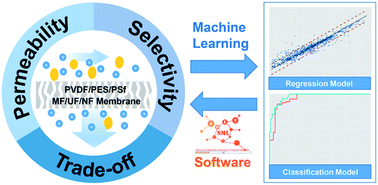Predicting the performance of polyvinylidene fluoride, polyethersulfone and polysulfone filtration membranes using machine learning†
Abstract
Micro/ultra/nano-filtration membranes based on polyvinylidene fluoride, polyethersulfone and polysulfone are advancing steadily in laboratory research and scalable production. Variables associated with the composition, fabrication, and operation are highly diverse, and their quantitative correlations with the core performance in permeability, selectivity and their trade-off are still elusive. To predict the performance based on a comprehensive dataset with 1895 vectors, the coefficient of determination spans from 0.79 to 0.85 for regression models, and the area under the receiver operating characteristic curve (AUC) reaches from 0.94 to 0.97 for classification models to distinguish the top 20% (Pareto set) and top 50% (balanced set) membranes with superior performance in the separation of macromolecules and salts from water. Further including experimental structural information (porosity, thickness, surface contact angle and roughness) brings significant improvement for regression models, while filling with predicted values only shows marginal improvement. A standalone algorithm that integrated the predictive models was released at https://github.com/polySML/polySML to facilitate the development of advanced filtration membranes through virtual experiments.

- This article is part of the themed collection: Editor’s Choice: Machine Learning for Materials Innovation


 Please wait while we load your content...
Please wait while we load your content...